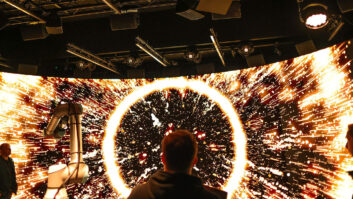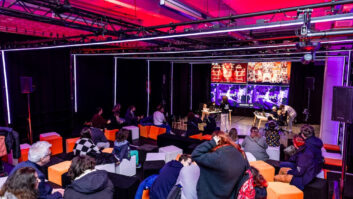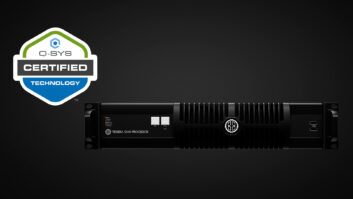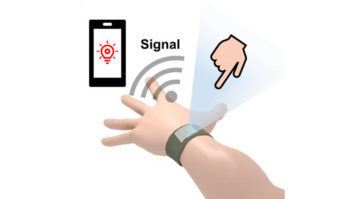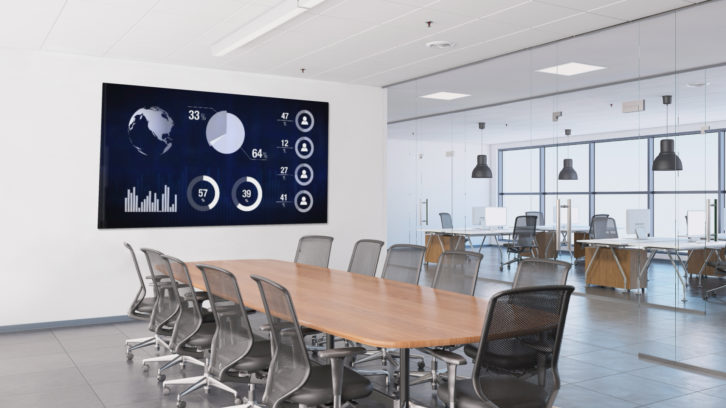
In the first part of this AV2030 feature we revealed that AV is in a good position with strong growth predicted to continue. We also discussed the markets that are driving this growth and revealed the tech that is on the decline and may be considerably marginalised by 2030. Here Ian McMurray looks at the technologies and markets on the rise such as AI and automation as well as the ecosystems that will emerge to tie everything together.
For everything that goes away, something new will, of course, come along. If the picture doesn’t look too bright (sic) for projection, for example, the industry seems unanimous that the coming decade will see direct view LED displays – which only a couple of years ago seemed fairly exotic – sweep all before them.
“Direct view LED technology is viewed as the heir apparent within the display market,” notes Sean Wargo, who is senior director of market intelligence for AVIXA, “thanks to its evolutions and improvements. We don’t see it dominating the display market within the next five years – but by 10 years out, it may account for half of display revenues.”
“The LED industry will continue to mature,” confirms Claire Kerrison, senior market analyst professional displays at Futuresource. “Technology developments and price declines will see it compete directly with LCD solutions towards the end of the next decade, even in mainstream applications like presentation.”
“Direct view LED technology is viewed as the heir apparent within the display market”
Sean Wargo, AVIXA
“Recent technology developments, finer pixel pitches and reducing costs are seeing LED start to become a viable mainstream option for large digital surfaces,” believes Jasmin Stemmler, product marketing manager, NEC Display Solutions Europe, whose company recently added to its growing family of dvLED displays. “As standardised bundles are reducing the perceived complexity of LED and local integrators receive the necessary training, there are few obstacles standing in the way of more intense progress for this technology which, at the high end, is offering incredibly long life cycles and making a strong TCO argument.”
What else is out there that once seemed leading edge, but that will become commonplace over the coming 10 years?
Seamless experience
“Functionalities such as verbal interaction will become much more mainstream,” believes Poly’s vice president of SE EMEA Andrew Hug. “Users no longer want to use a remote control or to push multiple buttons to join a call – the experience should be seamless with the use of voice commands.”
“Personalised interactions will also become mainstream for AV technologies,” he continues. “Employees of the future will expect meeting room technology to recognise them as they walk through the door, know that they have an upcoming call and join it automatically based on facial and voice recognition.”
“The development of automated technologies will signify a marked change of pace for how AV will function in the near future”
Carl Standertskjold, Sony Professional
Face and voice recognition are key branches of AI – and many believe it will proliferate throughout the AV industry in the future. Carl Standertskjold, European corporate segment marketing manager, Sony Professional, is among them. “The rate at which artificial intelligence and automation are being integrated into existing AV technologies is going to increase rapidly,” he says. “While this is already happening with real-time video content, handwriting extraction and automated overlays, the potential applications for this technology in the next 10 years is staggering.”
“Automation can decrease human error while enabling better decision making,” he goes on. “As technology transformations continue to take place across different sectors, the adoption and application of AI and automation will grow. While maximum productivity is an ever-present goal for businesses, the development of automated technologies will signify a marked change of pace for how AV will function in the near future.”
That kind of automation is something that Rob Smith, senior director, integrated systems sales at Shure, sees too. “We’ll see monitoring capabilities, noise rejecting microphone technologies, capabilities for systems to react automatically to changes in the environment they are deployed in,” he says.
Winning ecosystems
Klas Dalbjörn, product manager at Powersoft, picks up Kerrison’s earlier point about the growing importance of complete ecosystems. “Cloud-based remote system management will likely be more widely adopted,” he believes. “Some winning ecosystems will emerge that tie systems together in a more natural way, rather than being in separate ‘silos’. This will allow the system designer to configure and implement control of the system at a higher, more abstracted level.”
“Some ecosystems will become dominant,” he goes on, “and every manufacturer will need to adapt to at least one of the winning ecosystems in order to stay in business.”
Standertskjold mentioned the growing importance of AI in the AV industry – but what other technologies or themes will drive what customers buy over the next 10 years? What about big data, for example? For most, there is no doubt that we are already living in a world awash with far more data than we can reasonably put to good use – and that will only continue. Any discussion of it will inevitably lead to discussion of the role of the IoT in capturing and disseminating that data from a plethora of connected devices, and of the role of machine learning and analytics in turning it into actionable information.
“Once we have all of our disparate pieces of technology talking to each other via the IoT, we will build up a massive amount of data,” says Smith. “The question is then: what do we do with it? Possibilities include developing real information about usage patterns to inform product and system development. For example, if Shure is able to obtain information on how long Axient Digital ADX transmitters are usually used for between recharges around the world, that can inform the development of battery capacity in future products.”
Real benefits
“If you combine IoT, big data and machine learning capacity, we can start to see some real benefits for end users,” he continues. “For example: imagine a situation where a large number of rooms have been deployed and, over a period of time, faults have been detected and resolved. All of this data is centrally held and machine learning systems are in place, which may enable fault prediction on a statistical basis to become a reality – and perhaps even self-healing systems.”
Poly’s Hug sees advantages for the worlds of conferencing and collaboration. “Machine learning is being used in premium cameras to optimise meetings by identifying attendees and deciding on the most appropriate videoconferencing display format,” he explains. “For example, automatically panning out when larger groups are detected or zooming in on active speakers.
“This layer of intelligence in AV solutions will increase, bringing personalisation to every individual meeting. By analysing meeting interactions, cameras will be able to make decisions to create a better, more contextual meeting experience – for example, showing a split screen if two remote participants are having an ongoing conversation. Machine learning is also aiding noise reduction in AV solutions by tuning in to the background noise of each piece of equipment and adapting to what it hears – reducing distractions and enhancing the voices of those who are speaking to greatly improve the quality and flow of conversation.”
www.avixa.org
www.futuresource-consulting.com
www.nec-display-solutions.com
www.poly.com
www.powersoft-audio.com
www.shure.eu
www.sony.com
